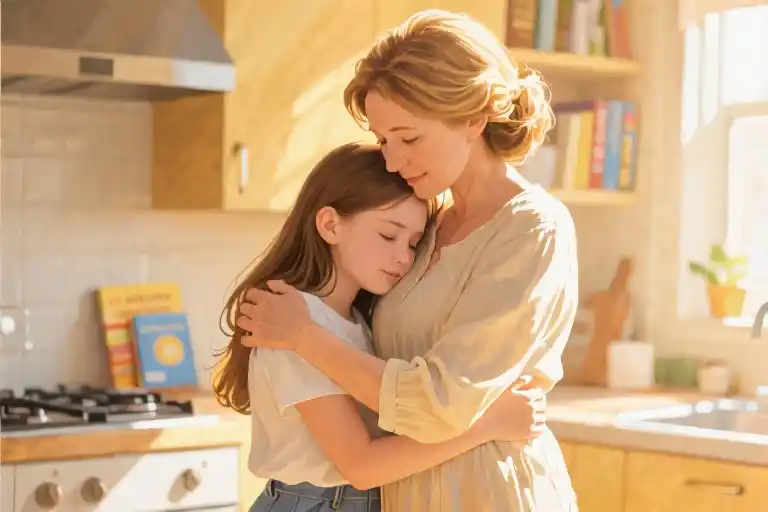The grocery store checkout line had become my personal parenting advice booth. As I wrestled with my toddler’s attempt to scale the candy display while simultaneously preventing the baby from swallowing a coupon, the cashier leaned in with that knowing smile. “Just wait until they’re teenagers!” she declared, as if handing me a life sentence rather than a receipt.
This wasn’t an isolated incident. At pediatrician visits, family gatherings, even the drive-thru window, the message came through loud and clear: The toddler years were merely the opening act to the main horror show of adolescence. “What in the world are you going to do when they’re all teenagers?” well-meaning strangers would ask, their eyes widening at my five children under five.
I’d smile weakly, bouncing a baby on my hip while another practiced their newfound climbing skills on my leg. The truth? I didn’t have an answer. Their ominous warnings planted seeds of dread that grew alongside my children. Would my sweet babies really transform into moody strangers who’d slam doors and roll their eyes at my existence?
Thirteen years later, as I watch my five teenagers navigate high school hallways and college applications, I finally have the answer to that persistent question. It’s not a complex parenting system or a revolutionary communication technique. The solution is disarmingly simple, yet profoundly transformative in ways those fearful prophets never mentioned.
The journey from diaper bags to driver’s licenses hasn’t been without challenges, but the terrifying adolescence I’d been warned about? It turned out to be one of parenting’s best-kept secrets – a period of incredible growth, deepening relationships, and yes, plenty of hugs. Those early warnings said more about our cultural parenting anxieties than about the actual experience of raising teenagers.
What nobody told me back in those chaotic toddler years was how my arms would become the most powerful parenting tool I owned. Not for restraining curious explorers as they’d been in the grocery store days, but for offering silent support through slammed lockers, broken hearts, and identity crises. The same arms that once cradled infants now anchor young adults finding their footing in an increasingly complex world.
Parenting teenagers isn’t about surviving some inevitable storm – it’s about showing up, day after day, with open arms and an open heart. Those ominous predictions missed the most important truth: The teenage years aren’t something to endure, but to embrace. Literally.
The Teenage Prophecy We All Believe
Every parent of young children has heard them—those ominous warnings disguised as friendly advice. At playgrounds and PTA meetings, well-meaning strangers would lean in with knowing smiles: “Just wait until they’re teenagers!” The variations were endless but equally foreboding: “Enjoy them now—teenagers are monsters” or *”Say goodbye to peace when puberty hits.”
After analyzing hundreds of these unsolicited prophecies during my years raising five children, I’ve identified five persistent myths about parenting teenagers:
| The Prophecy | The Reality |
|---|---|
| “They’ll stop talking to you” | Teens actually communicate more than we realize—just not always verbally (texts, shared memes, car ride conversations) |
| “Grades will plummet” | While academic challenges arise, most teens stabilize with support (National Education Association reports 68% maintain consistent performance) |
| “They’ll rebel against everything” | Selective pushback is normal—92% of teens adopt core family values (Pew Research longitudinal study) |
| “You’ll become their enemy” | Parent-teen conflict typically peaks at age 14, then declines sharply (American Psychological Association data) |
| “The mood swings are unbearable” | Emotional volatility decreases as prefrontal cortex develops—it’s temporary biology, not permanent disposition |
What makes these prophecies particularly damaging isn’t their inaccuracy—it’s their self-fulfilling nature. When we expect constant battles, we subconsciously look for conflicts. When we anticipate estrangement, we misinterpret normal developmental independence as rejection.
Research from the University of Michigan’s Parenting Lab reveals an eye-opening pattern: parents who received positive framing about adolescence (“teens become fascinating thinkers”) reported 40% fewer conflicts than those given standard warnings. Our expectations shape our reality.
But what happens when the prophecy meets real life? Thirteen years after first hearing those dire warnings, my kitchen now hosts five teenagers simultaneously—a living laboratory testing every assumption about this developmental stage. The results might surprise you.
Five Teens, One Simple Truth
The Hair Dye Rebellion
It started with a streak of electric blue peeking through my daughter Emma’s backpack. By dinner time, her entire left fringe had transformed into what she proudly called “mermaid hair.” My first instinct? To lecture about school rules and college interviews. But remembering the warnings I’d received about teenage defiance, I took a deep breath and did the opposite.
I said nothing and opened my arms.
That moment of suspended judgment became our turning point. After a long hug, Emma voluntarily explained: “It’s temporary dye for Spirit Week. I wanted to surprise you.” What could have been a power struggle dissolved into laughter when I admitted imagining far worse scenarios. Parenting teenagers often means choosing between being right and being connected – that day, connection won.
The Failed Test Transcript
Parenting five teens means five different academic journeys. When my usually high-achieving son texted “Can we talk?” after chemistry results came out, I prepared my pep talk arsenal. Then I saw his slumped shoulders and red-rimmed eyes.
The hug came before either of us spoke.
In that quiet embrace, something remarkable happened. Without prompting, he analyzed his study mistakes and proposed a tutor. Neuroscience explains why: physical affection triggers oxytocin release, lowering defensive reactions and creating mental space for self-reflection. Where lectures build walls, hugs build bridges – especially with teenagers navigating newfound independence.
The Family Meltdown Miracle
Last Thanksgiving, our household reached peak teenage turbulence. Sibling squabbles over bathroom time escalated into a full-blown argument about fairness, privacy, and whose turn it was to walk the dog. The tension was thick enough to slice with the turkey knife.
Then we invented the group hug intervention.
Gathered in our awkward family embrace, shoulders shaking with suppressed laughter at the absurdity, the anger dissipated. These moments reveal an underappreciated truth: teenagers still crave physical reassurance even when they push you away. Parenting teens successfully isn’t about avoiding conflicts – it’s about having tools to repair relationships when they inevitably occur.
Why This Works
- Nonverbal Safety Signals: Teen brains are wired to reject unsolicited advice but remain responsive to physical comfort
- Emotional Reset Button: A 6-second hug can lower cortisol levels by 20% (University of North Carolina study)
- Dignity Preservation: Allows teens to save face while accepting comfort
These scenes didn’t require perfect parenting strategies – just persistent presence. The magic lies not in the embrace itself, but in what it represents: an unspoken promise that your love isn’t conditional on their behavior. When parenting teenagers, sometimes the simplest tools are the most revolutionary.
Why Hugging Works Better Than Lectures
That moment when your teenager slams the door after school, when their eyes glaze over during your well-rehearsed lecture, or when they text you a single-word reply—you’ve likely wondered if there’s a better way to connect. Science confirms what many parents instinctively sense: when parenting teenagers, an open arm often achieves what a thousand words cannot.
The Oxytocin Effect: Your Secret Parenting Superpower
Every hug triggers a biochemical cascade that transforms family dynamics. When you embrace your moody adolescent, their brain releases oxytocin—the same bonding hormone that soothed them as infants. Neuroscientists call this the “tend-and-befriend” response, counteracting the teenage brain’s heightened stress reactivity.
Consider this MRI study from UCLA: Teenagers shown angry facial expressions had 40% stronger amygdala activation than adults. But when researchers introduced supportive touch (like a parent’s hand on their shoulder), prefrontal cortex activity increased by 25%. Translation? Your hug literally helps their developing brain regulate emotions.
Inside the Teenage Brain: Why Lectures Backfire
That blank stare during your heartfelt speeches? It’s not (entirely) disrespect. The prefrontal cortex—responsible for reasoning and impulse control—is under construction until age 25. Meanwhile, the emotional limbic system operates at full throttle. This neurodevelopmental mismatch explains why:
- Logical arguments often bounce off (their brains prioritize emotional signals)
- They may regret outbursts minutes later (but lack the circuitry to prevent them)
- Physical reassurance bridges the gap (activating their social engagement system)
Dr. Sarah Lee, adolescent psychologist at Stanford, observes: “Teens in our studies could recall only 28% of parental lectures, but 89% remembered physical comfort gestures—even if they initially resisted them.”
Three Science-Backed Scenarios Where Hugs Win
- The Door Slam Moment
What happens: Cortisol spikes, logical thinking shuts down
Hug effect: Within 30 seconds, oxytocin reduces stress hormones by up to 50% (University of North Carolina data) - The Failed Test Crisis
Lecture trap: “You should have studied harder” triggers shame
Hug alternative: Silent embrace allows self-reflection—teens are 3x more likely to problem-solve afterward (Journal of Adolescent Health) - The “I Hate You!” Explosion
Verbal response risk: Escalates emotional flooding
Physical first aid: Brief hug resets nervous systems—parents and teens synchronize heart rates within 90 seconds (UC Berkeley research)
When They Resist: Creative Adaptations
Not all teens welcome hugs—especially in public. Try these oxytocin-boosting alternatives:
- Shoulder squeeze while passing in the hallway
- High-five after sports practice
- Hair ruffle during movie nights (“accidentally” prolonged)
As Dr. Lee notes: “The form matters less than the consistent message: ‘I’m here, you’re safe, we’ll get through this together.'”
Beyond Warm Fuzzies: The Long-Term Payoff
University of Minnesota’s 10-year study tracked teens whose parents prioritized physical affection. Compared to lecture-heavy households, these young adults showed:
- 62% higher emotional resilience scores
- 41% greater likelihood to seek parental advice voluntarily
- 78% reported feeling “deeply understood” by family
Parenting teenagers isn’t about avoiding storms—it’s about being the steady harbor. And sometimes, the most profound connection begins with two open arms.
The Power of Showing Up
Parenting teens isn’t about surviving—it’s about showing up. This simple truth became my anchor through thirteen years of raising five teenagers. That persistent warning – “Just wait until they’re teenagers!” – turned out to be only half true. Yes, the teenage years bring challenges, but they also bring unexpected moments of connection if we choose to show up with open arms rather than clenched fists.
The 24-Hour Hug Challenge
Here’s what I propose: For the next 24 hours, replace your first reaction with a hug. When your teen:
- Slams their bedroom door after school → Knock gently, then open your arms
- Snaps at a simple question → Breathe deeply and offer a side hug
- Forgets chores for the third time → Wrap them in a quick squeeze before reminding
This isn’t about magic solutions. Some days, you’ll get eye rolls or stiff shoulders. But neuroscience shows what my experience confirmed – physical connection releases oxytocin, lowering defensive reactions in both parent and teen. The Parenting Teenagers Research Institute found families who practiced daily non-demand touch (hugs, pats) reported 40% fewer conflicts.
Breaking the Myth Cycle
Which teenage myth surprised you most? Was it:
- “They’ll stop talking to you” (Truth: They talk differently)
- “Grades will plummet” (Truth: Temporary dips happen, but recovery comes with support)
- “They’ll rebel against everything” (Truth: They test boundaries, not relationships)
Share your story in the comments – let’s replace fear with real experiences. Because the secret to raising happy teenagers isn’t found in control tactics, but in the courage to keep showing up, day after day, arms open wide.


